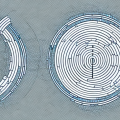The radian unit circle is an essential tool for understanding trigonometry and can be used to find angles and measure distances on a unit circle. To use the radian unit circle effectively, it’s important to first understand what a radian is, how it differs from degrees, and how to calculate radians. Additionally, it’s important to learn how the radian unit circle is used to solve trig equations, find major and minor arc lengths, and measure distances on the unit circle.
What Is a Radian?
A radian is a unit of measure for angles on the unit circle. It is equal to the quotient of the length of an arc divided by the radius of the circle. The radian is the most commonly used angle measurement in mathematics, and it is denoted by the Greek letter ‘π’. One full revolution around the unit circle is equal to 2π (or 6.28) radians.
Radians are also used to measure angles in other contexts, such as in trigonometry and calculus. Radians are often used in place of degrees when measuring angles, as they are more precise and easier to work with. Radians are also used to measure the angular velocity of a rotating object, such as a wheel or a fan.
Measuring Distances on the Unit Circle
To measure arc lengths on the unit circle, we can use a diagram of the unit circle to determine the distance an arc covers. The distance an arc covers indicates how many radians it corresponds to. To measure an arc, simply identify the two points on the circle which define the arc and measure the length between them. For example, consider the arc between points D and E on the diagram.
To measure the arc length, we can use the Pythagorean theorem to calculate the distance between the two points. The distance between the two points is equal to the square root of the sum of the squares of the differences in the x and y coordinates of the two points. Once we have the distance, we can use the formula for arc length to calculate the number of radians the arc covers.
Radians vs Degrees
Radians and degrees are two different units for measuring angles on the unit circle. Degrees are most commonly used in everyday measurements like time, while radians are more commonly used in mathematical equations and calculations. Ultimately, they measure the same thing—the arc length around a circle relative to its radius—but their units are different. One full revolution around the unit circle corresponds to 360° in degrees, or 2π radians.
Radians are often preferred in mathematics because they are easier to work with in equations. For example, the sine and cosine functions are simpler to calculate when expressed in radians. Additionally, radians are more accurate when measuring angles in a circle, as they are based on the radius of the circle, rather than a fixed number of degrees.
Trig Functions and Radians
Trigonometry relies on the radian unit circle to help solve equations involving angles. The basic trigonometric functions—sine, cosine, and tangent—are usually defined in terms of their relationships with the sides of a right triangle. However, when expressed in terms of radians, these functions can also be expressed as ratios which involve distances on the unit circle.
Major and Minor Unit Circle Arc Lengths
When measuring distance on the unit circle, there are two types of arcs: major arcs, which pass through two points on the same side of the x-axis; and minor arcs, which pass through two points on opposite sides of the x-axis. For example, consider the two arcs between points A and B, and between points C and D on the diagram. The arc between points A and B is a major arc, while the arc between points C and D is a minor arc.
Using the Radian Unit Circle to Find Angles
By combining knowledge of radians and trigonometric functions, we can use the radian unit circle to find angles. To do this, find the lengths of major or minor arcs which correspond to the angle you seek. Then use one of the trigonometric functions to determine the measure of that angle in radians.
Using Radians in Trigonometric Equations
Trigonometric equations can be solved using knowledge of radians and trigonometric functions. To solve such equations, first identify what parts of the equation are known quantities (like the measure of an angle in radians). Then use a system of equations along with trigonometric functions to find any unknown quantities.
How to Calculate a Radian
Radians are calculated using two pieces of information—the length of an arc, and the radius of a circle. First measure the length of an arc on the unit circle. Then divide that measurement by the radius of the circle. The result will be a value in radians.
Practical Applications of the Radian Unit Circle
The radian unit circle is essential for understanding Trigonometry and its practical applications. It helps us solve equations involving angles and measure distances on circles, among other things. It’s used in calculating electricity rates, navigation systems, and radar waves, among other practical applications.





